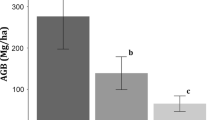Abstract
The article presents the results of an analysis of the reaction to the possible reduction of dominants in forest stands of the Western Caucasus. It is found that in such cases it is likely that an increase in the abundance of accompanying species, an expansion of the range of their habitats, and the emergence of new species will be observed. It is noted that in some types of forest stands the abundance of just one accompanying species, mainly subdominant, will increase; in some types, that of two or three species will increase; and in some types that of the majority of accompanying species will increase. These differences may result from different proportions of tree species with different life strategies in the community.
Similar content being viewed by others
References
Akatov, V.V., Structure of domination in the wood stands of Western Caucasus: factors and mechanisms, Usp. Sovrem. Biol., 2014, vol. 34, no. 3, pp. 257–269.
Akatova, T.V., Leafy mosses, in Osobo okhranyaemye vidy zhivotnykh, rastenii i gribov v Kavkazkom zapovednike (Strictly Protected Species of Animals, Plants, and Fungi in Caucasus Biosphere Nature Reserve), Tr. Kavkaz. Zapoved., Maikop: Kachestvo, 2009, no. 19, pp. 164–170.
Aksenova, A.A., Onipchenko, V.G., and Blinnikov, M.S., Experimental study of plant relationships. Dominant removals. Alpine lichen heats, in Alpine Ecosystems in the Northwest Caucasus, Onipchenko, V.G., Ed., Dordrecht: Kluwer, 2004, pp. 236–244.
Begon, M., Harper, J., and Townsend, C., Ecology: From Individuals to Ecosystems, Oxford: Blackwell, 1986.
Bibin, A.R., Hymenoptera. Fam. Xyelidae, in Osobo okhranyaemye vidy zhivotnykh, rastenii i gribov v Kavkazkom zapovednike (Strictly Protected Species of Animals, Plants, and Fungi in Caucasus Nature Reserve), Tr. Kavkaz. Zapoved., Maikop: Kachestvo, 2009, no. 19, p. 73.
Cherednichenko, O.V., Experimental study of plant relationships. Dominant removals. Removals in the Geranium gymnocaulon — Hedysarum caucasicum meadow, in Alpine Ecosystems in the Northwest Caucasus, Onipchenko, V.G., Ed., Dordrecht: Kluwer, 2004, pp. 244–250.
Cherpakov, V.V., Pathology of general forest forming species and their communities, in Ekologicheskie issledovaniya v Kavkazskom biosfernom zapovednike (Environmental Studies in Caucasian Biosphere Nature Reserve), Kurazhkovskii, Yu.N., Ed., Rostov-on-Don: Rostov. Gos. Univ., 1985, pp. 64–80.
Dolukhanov, A.G., Temnokhvoinye lesa Gruzii (Dark Coniferous Forests), Tbilisi: Metsniereba, 1964.
Dvoretskaya, E.V., Burst of infection of Buxus colchica in Sochi National Park, Ekol. Vestn. Sev. Kavk., 2011, vol. 7, no. 2, pp. 45–50.
Evstigneev, O.I., Mechanisms of maintenance of biological diversity of forest biogeocenosises, Extended Abstract of Doctoral (Biol.) Dissertation, Bryansk: Bryansk. Les Biospher. Zapoved., 2010.
Elagin, I.N., Oak forests of the western margin of northern slope of Caucasus Range, Shirokolistvennye lesa severozapadnogo Kavkaza (Broad-Leaved Forests of Northwestern Caucasus), Moscow: Akad. Nauk SSSR, 1953, pp. 187–244.
Grabenko, E.A., Bacteriosis of Nordmann fir in Western Caucasus, Lesnoi kompleks: sostoyanie i perspektivy razvitiya (Forest Complex: Status and Prospective Development), Bryansk, 2002, no. 3, pp. 16–18.
Grime, J.P., Evidence for the existence of three primary strategies in plants and its relevance to ecological and evolutionary theory, Am. Nat., 1977, vol. 111, no. 982, pp. 1169–1194.
Grudzinskaya, I.A., Broad-leaved forests of the foothills of Northwestern Caucasus, in Shirokolistvennye lesa severo-zapadnogo Kavkaza (Broad-Leaved Forests of Northwestern Caucasus), Moscow: Akad. Nauk SSSR, 1953, pp. 5–187.
Kiyashko, A.A., Macromycetes, in Osobo okhranyaemye vidy zhivotnykh, rastenii i gribov v Kavkazkom zapovednike (Strictly Protected Species of Animals, Plants, and Fungi in Caucasus Nature Reserve), Tr. Kavkaz. Zapoved., Maikop: Kachestvo, 2009, no. 19, pp. 170–181.
Lebedeva, N.V. and Krivolutskii, D.A., Biological diversity and its assessment, in Geografiya i monitoring bioraznoobraziya (Geography and Monitoring of Biodiversity), Moscow: Nauch. Ucheb.-Metod. Tsentr, 2002, pp. 8–76.
Leonova, N.B. and Ogureeva, G.N., Forest vegetation of moderate zone affected by global envirobmental changes, in Sovremennye global’nye izmeneniya prirodnoi sredy (Modern Global Environmental Changes), Moscow: Nauchnyi Mir, 2006, vol. 2, pp. 422–433.
Lur’e, P.M. and Panov, V.D., Shift in activity of snow avalanches on the northern slope of the Great Caucasus related climate conditions, Ekol. Vestn. Nauch. Tsentr. Chernomor. Ekon. Sotrudnichestva, 2006, suppl. 1, pp. 47–53.
Moseichenko, N.S., Improvement of biological resistance of plantations based on mechanisms of ecological diversity (by example of Krasnodar krai), Extended Abstract of Cand. Sci. (Biol.) Dissertation, Voronezh: Voronezh. Gos. Lesotekh. Akad., 2004.
Orlov, A.Ya., Temnokhvoinye lesa Severo-Zapadnogo Kavkaza (Dark Coniferous Forests of Northwestern Caucasus), Moscow, 1951.
Perevozov, A.G., Changes of species diversity and population density of birds — entomophages along high altitude gradient of Western Caucasus, Zool. Zh., 2011, vol. 90, no. 12, pp. 1492–1501.
Pitman, N.C.A., Terborgh, J.W., Silman, M.R., Nunez, P., Neill, D.A., Ceron, C.E., Palacios, W.A., et al. Dominance and distribution of tree species in upper Amazonian terra firme forests, Ecology, 2001, vol. 82, pp. 2101–2117.
Shcherbin-Parfenenko, A.L., Bakterial’nye zabolevaniya lesnykh porod (Bacterial Diseases of Forest Species), Moscow: Goslesbumizdat, 1963, pp. 21–24.
Shcherbin-Parfenenko, A.L., Ligachev, I.N., and Emel’yanova, N.F., New bacterial pathology of beech and other species, in Fitopatogennye bakterii (Phytopathogenic Bacteria), Kyiv: Naukova Dumka, 1975, pp. 285–288.
Spurr, S.H. and Barnes, B.V., Forest Ecology, New York: Wiley, 1980.
Vasilevich, V.I., Dominants in vegetation cover, Bot. Zh., 1991, vol. 76, no. 12, pp. 1674–1681.
Zhivotov, A.D., Dynamics of meteorological parameters in Caucasus Biosphere Reserve (1985–2005), in Osobo okhranyaemye vidy zhivotnykh, rastenii i gribov v Kavkazkom zapovednike (Strictly Protected Species of Animals, Plants, and Fungi in Caucasus Nature Reserve), Tr. Kavkaz. Zapoved., Maikop: Kachestvo, 2008, no. 18, pp. 6–22.
Author information
Authors and Affiliations
Corresponding author
Additional information
Original Russian Text © V.V. Akatov, 2015, published in Sibirskii Ekologicheskii Zhurnal, 2015, No. 4, pp. 528–536.
Rights and permissions
About this article
Cite this article
Akatov, V.V. Compensation reactions to the reduction of density of dominants in forest stands of the Western Caucasus. Contemp. Probl. Ecol. 8, 431–439 (2015). https://doi.org/10.1134/S1995425515040010
Received:
Accepted:
Published:
Issue Date:
DOI: https://doi.org/10.1134/S1995425515040010




